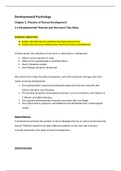Developmental Psychology
Chapter 2: Theories of Human Development
2.1 Developmental Theories and the Issues They Raise
LEARNING OBJECTIVES:
Explain why theories are needed in developmental science.
Outline the four issues addressed by theories of human development.
A theory guides the collections of new facts or observations, making clear:
What is most important to study
What can be hypothesized or predicted about
How it should be studied
How findings should be interpreted
We examine four major theoretical viewpoints, each with important messages about the
nature of human development:
1 The psychoanalytic viewpoint developed by Sigmund Freud and revised by Erik
Erikson and other neo-Freudians.
2 The learning perspective developed by pioneers such as Ivan Pavlov, John Watson, B.
F. Skinner, and Albert Bandura.
3 The cognitive developmental viewpoint associated with Jean Piaget
4 The systems theory approach, exemplified by Urie Bronfenbrenner’s bioecological
model.
Nature-Nurture
Is development primarily the product of nature (biological forces) or nurture (environmental
forces)? Different theories have taken different positions on the issue and it remains
centrally important in the study of human development.
Activity-Passivity
,Activity-Passivity Issue: focuses on the extent to which human beings are active in creating
and influencing their own environments, and in the process, in producing their own
development, or are passively shaped by forces beyond their control.
Some theorists believe that humans are curious, active creatures who orchestrate
their own development by exploring the world around them and shaping their
environments.
Other theorists view humans as passively shaped by forces beyond their control –
usually environmental influences but possibly strong biological forces.
Continuity-Discontinuity
Continuity-Discontinuity Issue: focuses in part on whether the changes people undergo over
the life span are gradual or abrupt.
Continuity theorists view human development as a process that occurs in small steps,
without sudden changes, as when grade school children gradually gain weight from
year to year.
Discontinuity theorists tend to picture the course of development as more like a
series of stair steps, each of which elevates the individual to a new (and often more
advanced) level of functioning.
Developmental Stages: a stage is a distinct phase of development characterized by a
particular set of abilities, motives, emotions, or behaviors that form a coherent pattern.
Universality-Context Specificity
The extent to which developmental changes are common to all (universal) or are different
across cultures, subcultures, task contexts, and individuals (context specific).
Checking Mastery:
1. What are the two meanings of discontinuity in development?
2. Stage theorists can disagree about a lot, but they are all likely to take certain stands
on the issues of nature-nurture, continuity-discontinuity, and universality0context
specificity. What stands?
2.2 Psychoanalytic Theory
, LEARNING OBJECTIVES:
Summarize the three parts of the personality and the five psychosexual stages in
Freud’s psychoanalytic theory.
Analyze how Erikson’s psychosocial theory differs from and expands on Freud’s
theory.
Explain the conflicts humans face as they move through Erikson’s eight psychosocial
stages.
Evaluate the strengths and weaknesses of Freud’s and Erikson’s theories.
Freud’s Psychoanalytic Theory: focused on the development and dynamics of the
personality, challenged prevailing notions of human nature and human development by
proposing that people are driven by motives and emotional conflicts of which they are
largely unaware and that they are shaped by their earliest experiences in the family.
Freud’s Legacy
Instincts and unconscious Motivation
Instincts: Freud viewed the newborn as an inherently selfish and aggressive creature driven
by instincts – inborn biological forces that motivate behavior.
Unconscious Motivation: the power of instincts and other inner forces to influence our
behavior without our awareness.
His theory emphasizes the nature side of the nature-nurture debate.
Id, Ego, and Superego
According to Freud, each individual has a fixed amount of psychic energy that’s used to
satisfy basic urges/instincts and to grow psychologically: id, ego, and superego.
Id: the impulsive, irrational, and selfish part of the personality of an infant that works to
satisfy instincts while seeking immediate gratification.
Ego: the rational side of the individual that tries to find realistic ways of gratifying the
instincts.
As ego matures, children can postpone gratification and develop appropriate and
realistic strategies while energizing cognitive processes such as perception, learning,
and problem solving.





